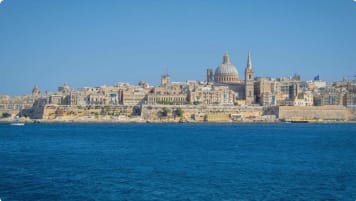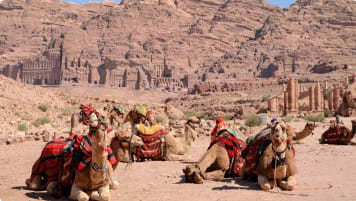Visiting Iran: A Definitive Guide for Travellers
Visiting Iran | Small group tours Iran Women visit a carpet store in Shiraz, Iran. Throughout history, Iran’s position in the centre of the famous Silk Road has seen it crisscrossed by travellers, traders and…
10 Oct 19 · 19 mins read
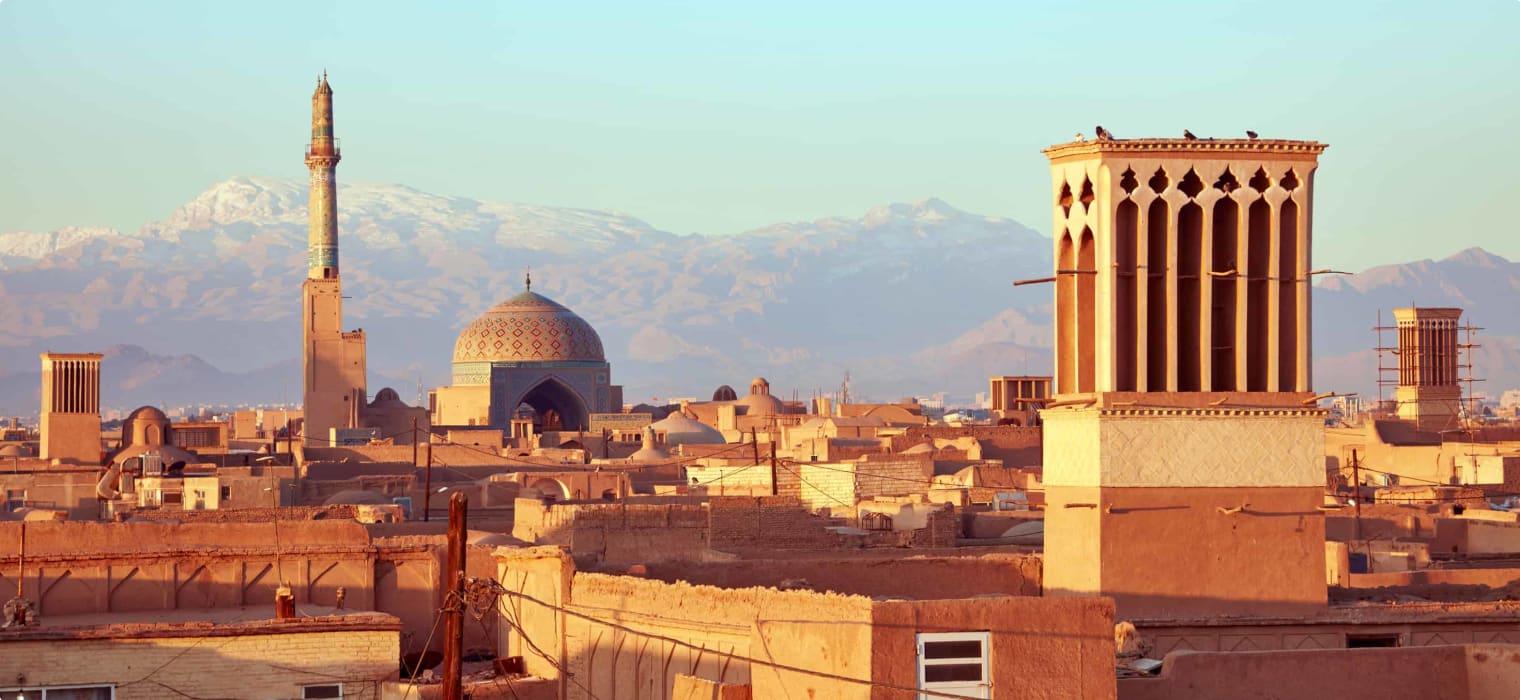
Visiting Iran | Small group tours Iran
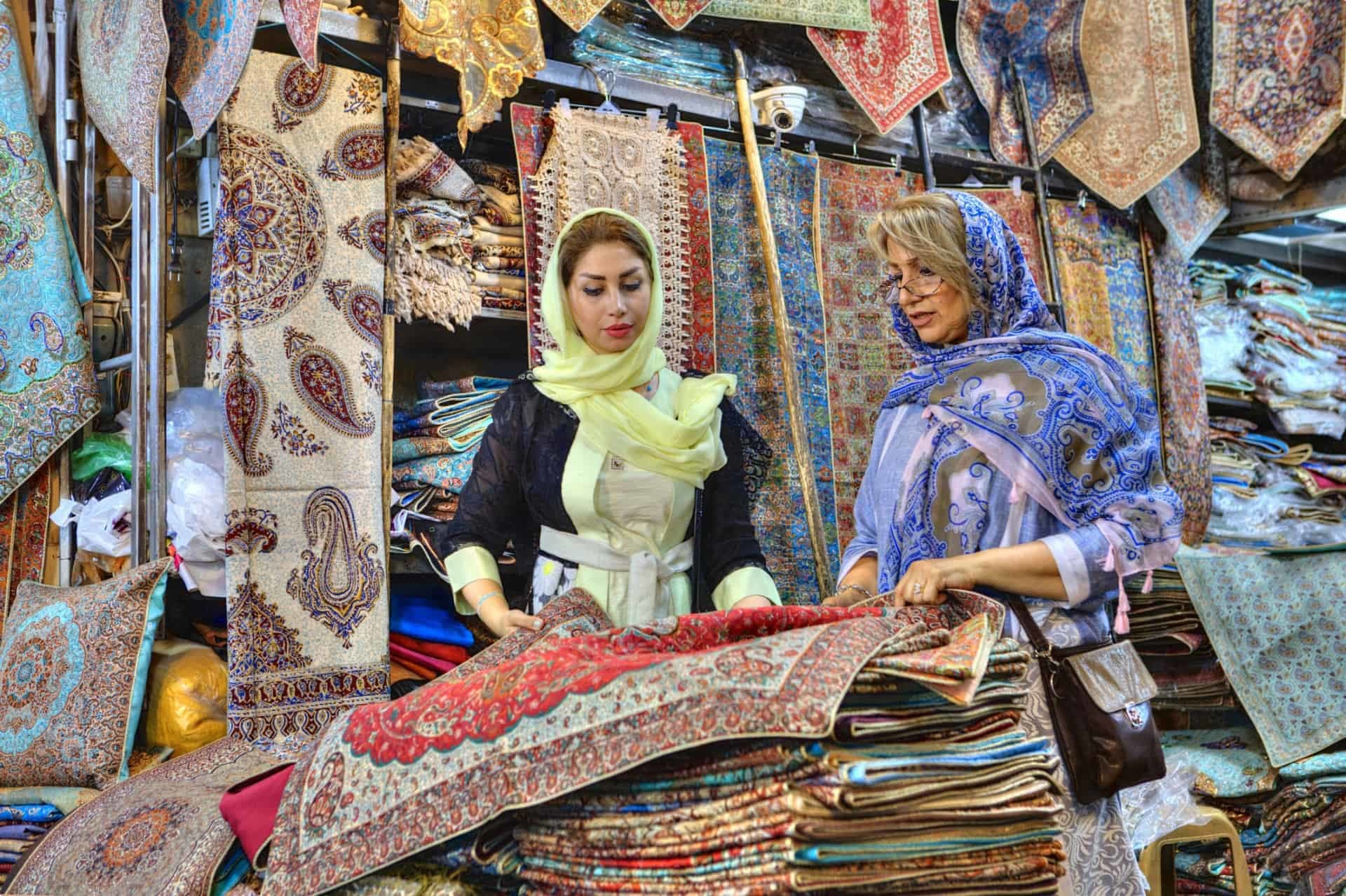
Throughout history, Iran’s position in the centre of the famous Silk Road has seen it crisscrossed by travellers, traders and armies. In more recent times, its rich oil resources and relations with its Sunni neighbours have brought it to international attention. While travel in Iran might seem a daunting prospect, the days of the Iranian Revolution and the Iran-Iraq War are long past: Iran is stable, safe, and once again attracting travellers as it has done for long years.
Travelling to Iran is easier than you might imagine. Visitors find that the Iranian people are incredibly welcoming; while Iran is full of fascinating culture and a long and rich history. Odyssey Traveller Australia now offers the opportunity to visit this extraordinary country.
If you’re interested in visiting Iran, you might also be interested in some of our other articles:
- Questions About Iran
- Tehran Through Time
- Safavids in Persia
- History of Persian Carpets
- Beauty and Artistry in Iran: Persian Gardens and Mosaic Tiles
- Persepolis in Iran, a famous place on any escorted small group tour
- Thirty must see places when visiting Iran
You might also be interested in our suggested list of Ten Books to Read About Iran.
This post surveys the key destinations and main highlights of our 17-day Iranian tour. We will give you an idea of:
- what to expect when choosing an Iranian tour,
- including the best times to travel
- and what to wear
Highlights of Iran:
Our escorted tour of Iran is an unforgettable experience. Its beautiful landscapes, welcoming people and magnificent art and architecture will long remain in your memory. It’s also a surprising experience, with many travellers finding their expectations completely overturned. Here are our recommendations for the main places you should definitely visit:
Isfahan
“Esfahan nesf-e jahan ast” (Esfahan is half the world) – Renier, a 16th century French poet
Isfahan (or Esfahan) is an essential stop when travelling in Iran. Capital of Persia in the 11th century and the 17th, Esfahan is packed with magnificent and grandiose imperial architecture. The first period as capital came in 1047, when the Seljuks made Esfahan their capital and adorned it with their magnificently geometric style of architecture. In 1598, Esfahan became capital for a second time under Shah Abbas the Great, who added many more beautiful buildings to the considerable wealth of history preserved in the construction of earlier periods.
The Maidan-e Naqsh-e Jahan (‘the image of the world square’) contains many of the main sights to see in Esfahan. This is the second largest square in the world, and its beauty owes much to the vision of Shah Abbas the Great. Construction began in 1602 as the centrepiece of his new capital, and consequently it became the home of the finest architectural jewels in the Safavid empire. Around 15 kilometres of bazaar surrounds the square, and the goal posts used in polo games over 400 years ago are still in place at either end. Locals and tourists flock here to enjoy its gardens and fountains, or shop in the surrounding bazaar.
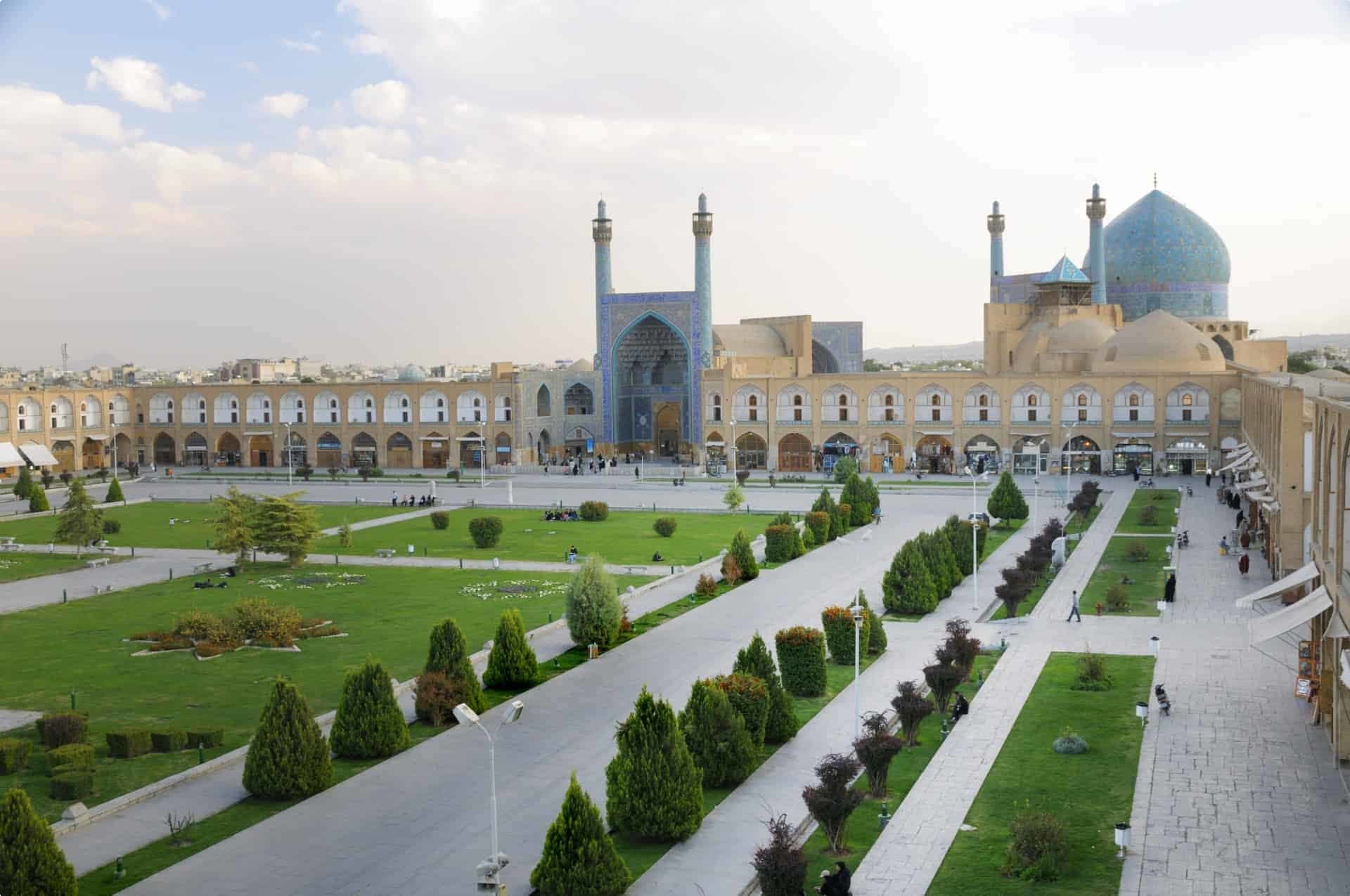
Highlights of the Maidan-e Naqsh-e Jahan:
- The Imam Mosque, the largest building attributed to Shah Abbas the Great. Work began on the magnificent entrance portal in 1611, which took four years to finish. Thirty metres tall, it has mosaics featuring geometric designs, floral motifs and calligraphy by the greatest artists of the age. While the mosque faces towards Mecca, the entrance portal is oriented to face the square, with a short, angled corridor connecting the two.
- The Sheikh Lotfollah Mosque, originally built for the Shah’s harem. Its pale dome makes use of delicate cream-coloured tiles that change colour throughout the day from cream to pink. Its portal boasts some of the best surviving Safavid era mosaics in the country.
- The Ali Qapu Palace, built at the end of the 16th century as a residence for Shah Abbas I. Its elevated terrace affords a wonderful perspective of the Square and one of the best views of the Imam Mosque.
- Chehel Sotun, built as a pleasure pavilion and reception hall. Today it’s most famous for its frescoes. Although Afghans whitewashed the frescoes during an 18th century invasion, they have since been uncovered.
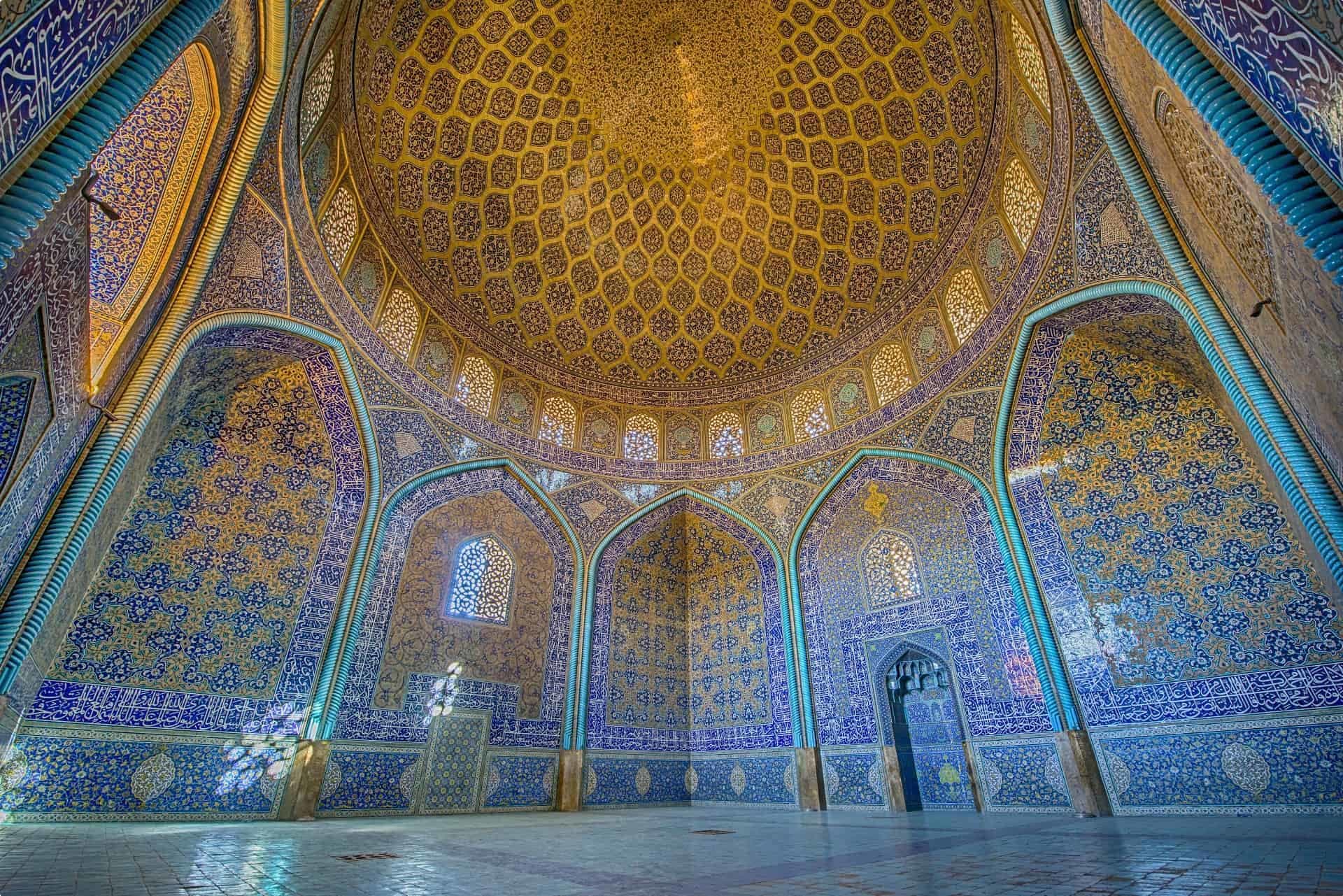
Other ‘don’t miss’ sights in Esfahan include the beautiful Khaju and Si-o-se-pol bridges over the Zayande River. Shah Abbas built several of these structures to serve as both reservoir-forming dams as well as bridges. The Khaju Bridge is arguably the finest. Its 110 metre length has two levels of terraced arcades, the lower containing locks to regulate the water flow. The remains of some of the original painting and tiles can still be seen, as well as stone seats built for the Shah to sit on to admire the view. Si-o-se-pol Bridge is 298 metres long, with 33 arches that give it its name. It links the upper and lower halves of the Chahar Bagh, the tree-lined main street that runs through the centre of Esfahan
On the south bank of the river is Jolfa, which was the Armenian quarter in Shah Abbas I’s time. He transported a colony of Christians from the northern town of Jolfa, needing their skills as merchants, entrepreneurs and artists. These Armenian Christians built the Cathedral of the Holy Saviour (the Vank Cathedral), between 1606 and 1655. Its richly decorated interior is the focal point of the Armenian Church in Iran.
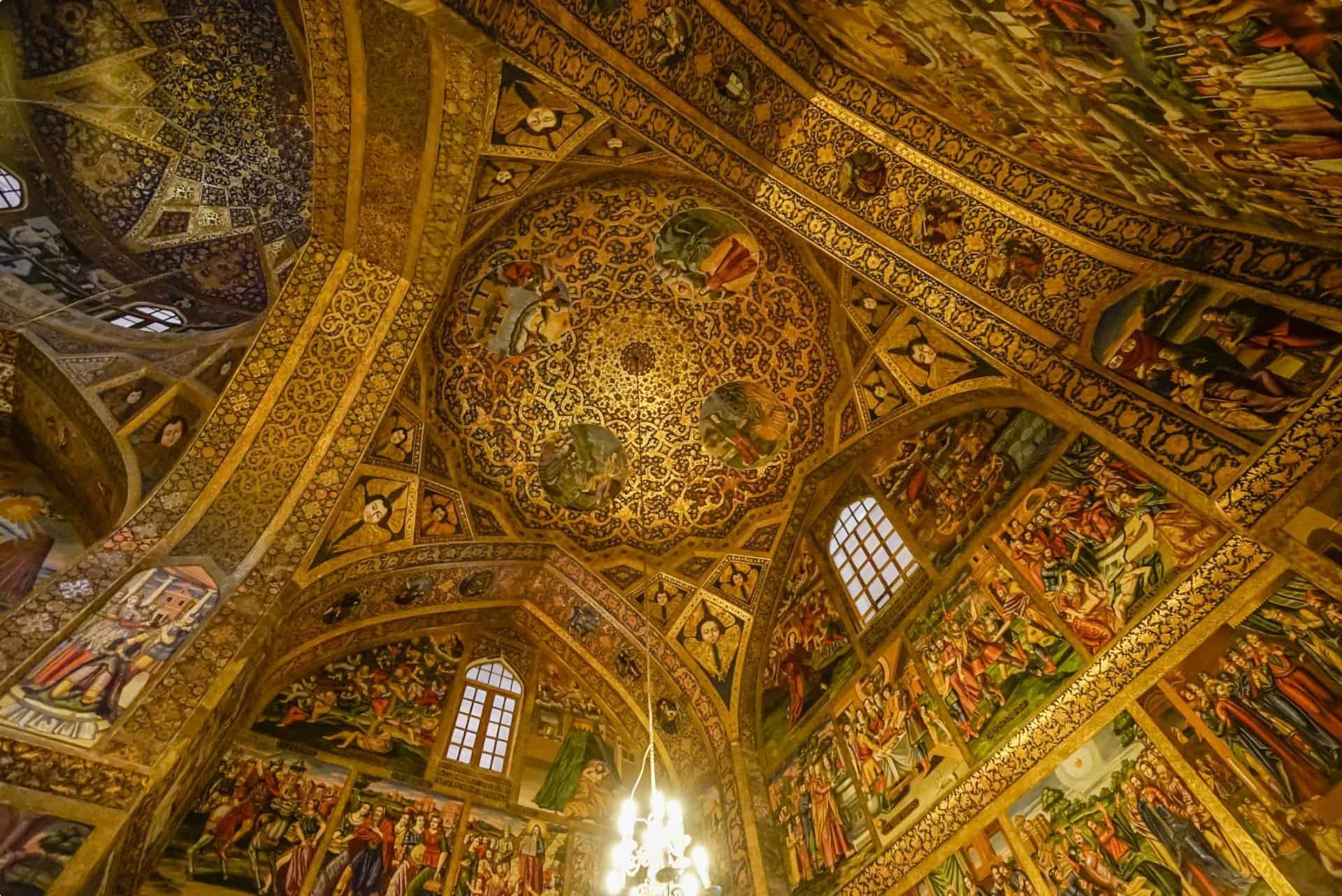
Shiraz:
Shiraz is a city of over 1 million people in the southern Zagros mountains province of Fars. Once a much larger region, its language, Farsi, became the official language of the Persians. Shiraz held a pivotal role in the later history of Persia, particularly after the Arab invasion. It became the literary capital thanks, in part, to the reputations of the poets Sa’di, who died in 1291, and Hafez, who died in 1389. In the mid-1700s, Shiraz became the official capital of Iran under the Zand dynasty. Many of the most beautiful buildings were built or underwent restoration in this period. Always a centre for learning and fine living, Shiraz fortunately escaped destruction by Genghis Khan and Tamerlane’s forces. In the Safavid period, European traders came here to export the city’s famous wine.
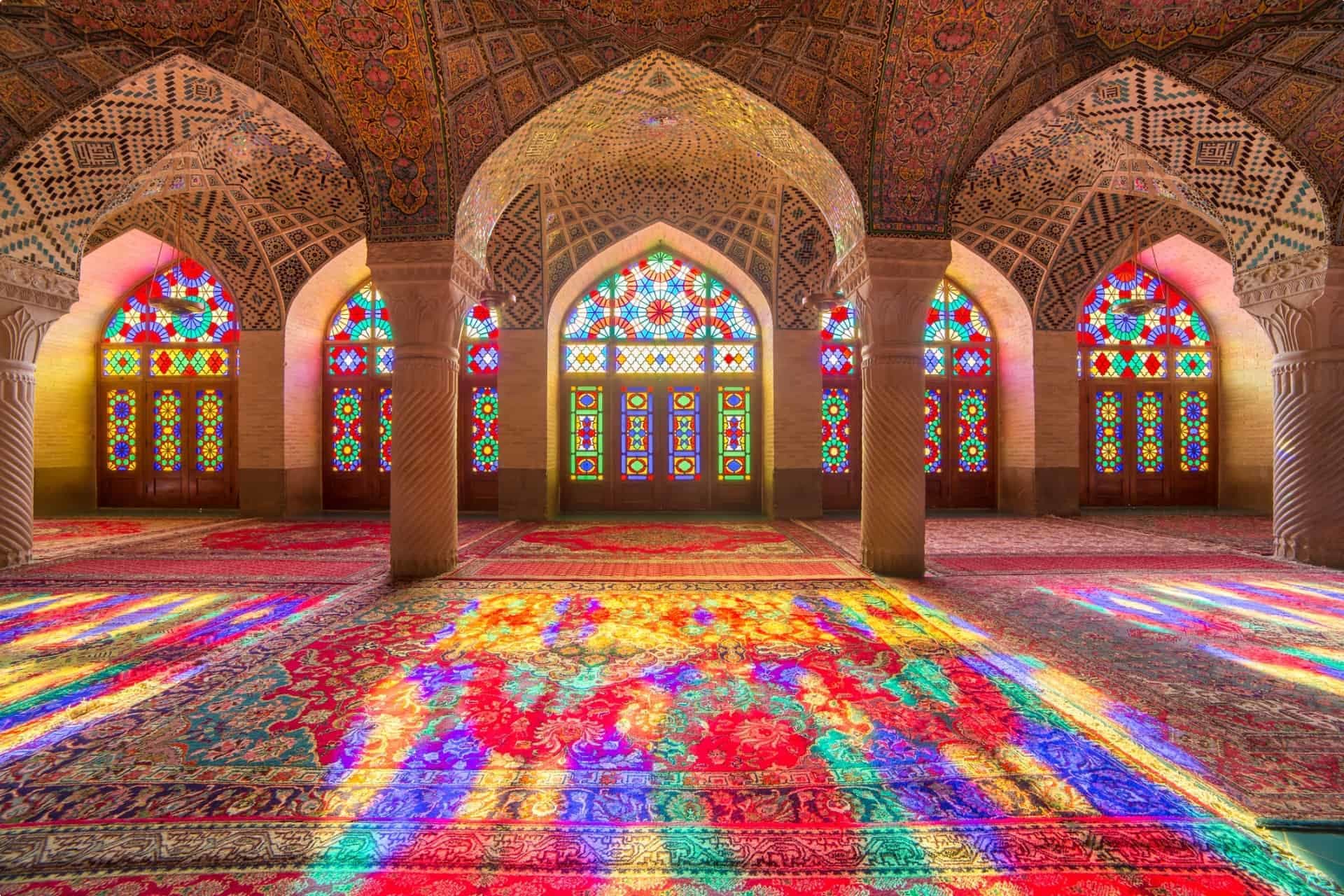
When in Shiraz, don’t miss:
- The Arg-e Karim Khan, in the centre of Shiraz itself. The Arg is a citadel, built during the early Zand period as part of the royal court. Iran’s ruler at the time, Karim Khan, hoped Shiraz would rival Esfahan. Its design combines military and residential architecture, as it was the home of Karim Khan and his military base. After the fall of the Qajar dynasty it became a prison, and in 1971 Iran’s Cultural Heritage Organisation took over its management and began renovations in 1977.
- The photogenic Vakil Bazaar, in the historical center of the city. First built in the 11th century, it’s a wonderful place to have lunch and spend time wandering around.
Must see places around Shiraz

- Pasargadae, built by Cyrus the Great, founder of the Achaemedian Empire in around 546 BCE. His tomb, private palace and audience palace still survive.
- Persepolis, known locally as Takht-e Jamshid (‘Jamshid’s Throne’), after a legendary king. It’s undoubtedly one of the highlights of a visit to Iran, a vast array of magnificent ruins conveying the splendour of Achaemenid Persia. Persepolis is renowned for its monumental architecture, urban planning, construction technology and art. Work began when Darius the Great took the throne in 518 BCE, and later kings including Xerxes I and II and Artaxerxes I, II and III all made additions. Eventually it spread over 125,000sqm and was one of four cities at the heart of an empire that spread from the Indus River to Ethiopia. During the annual Nowruz (New Year) celebrations, subjects came from across the empire to pay homage and tribute to their kings. Alexander the Great burned Persepolis to the ground in 330 BCE, and it was lost for centuries under dust and sand until excavations in the 1930s. Although Alexander’s historians wrote of its total destruction, significant areas of the centre remain – along with some of the greatest sculpture found in Iran today. (To read more about Persepolis, click here.)
- Naqsh-e Rostam, magnificent royal tombs hewn out of a cliff high above the ground. The structures are thought to contain the tombs of Darius II, Ataxerxes I, Darius I and Xerxes I. The openings lead to chambers for bone storage, once the carrion birds had cleaned them up. The reliefs above the openings show the kings standing at fire altars, supported by figures representing their subject nations. Eight Sassanian stone reliefs are cut into the cliff, depicting scenes of imperial conquests and royal ceremonies.
Tehran:
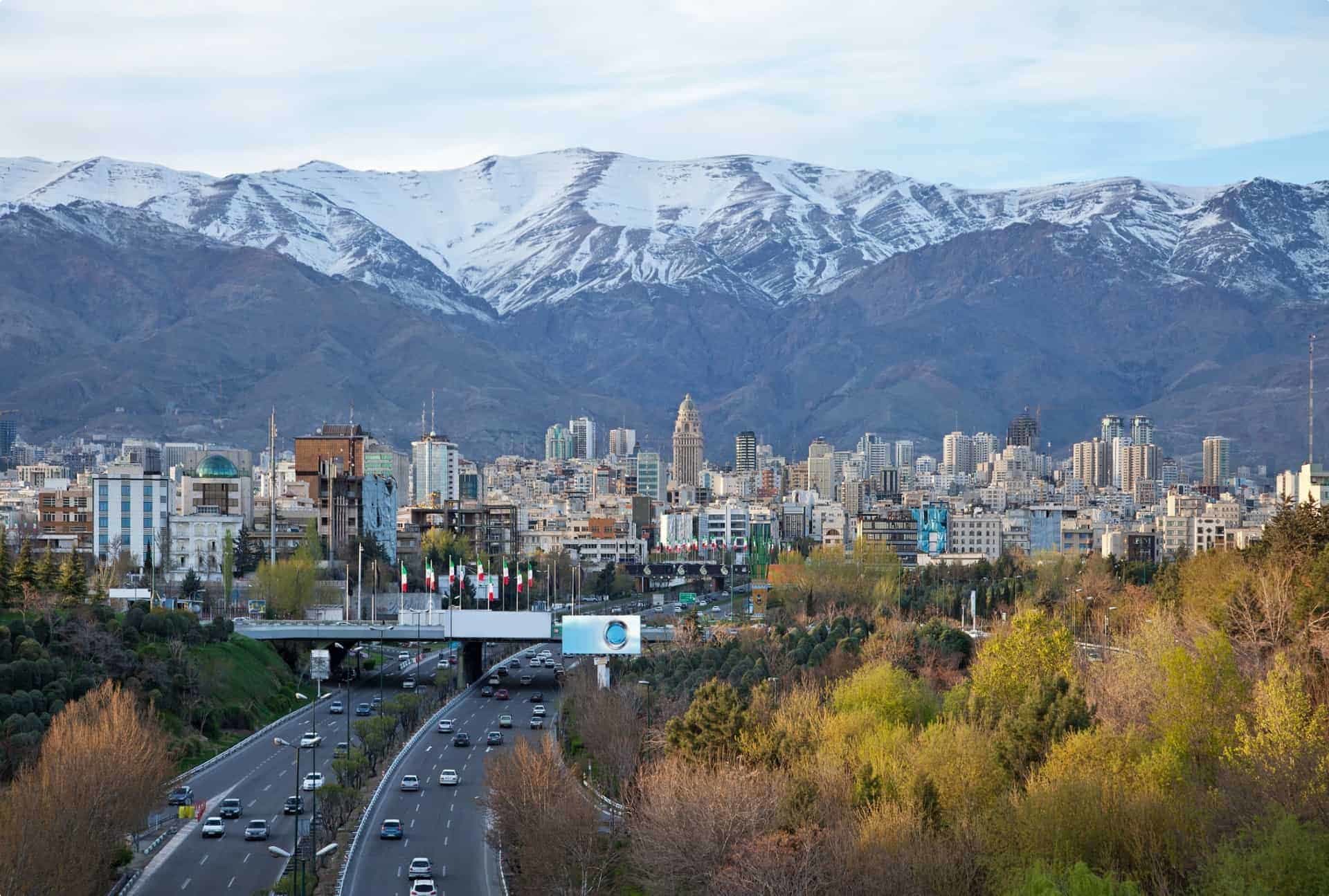
Tehran was first known in the 13th century as the village of Rey, at that time the main urban centre under the Achaemenid Empire After its sacking by the Mongols in 1220, the survivors fled to Tehran, turning the village into a moderately prosperous trading centre. In the 16th century the Safavid king Tahmasb I laid out gardens, caravanserai, and a wall with 114 towers to protect the town. It continued to grow during the 18th century and became Iran’s 32nd capital city in 1795. The palaces and gardens of the 18th century Qajar dynasty and the following Pahlavis are now places of interest, along with Tehran’s wonderful museums.
Places of interest in Tehran
- The Sa’ad Abad Museum complex is set within 104 hectares of parkland. The Pahlavis used it as their summer home. Today, the complex is home to several different museums: the White Palace, the Pahlavi’s summer residence; the Green Palace, built at the end of the Qajar era; the Nation’s Art Museum, Military Museum and the Museum of Fine Arts.
- The National Museum of Iran has a wonderful collection of artifacts from excavations including Persepolis. Highlights include inscriptions, a statue of a wonderfully life-like mastiff and an Elamite statue of a bull from the 2nd millennium BCE.
- The National Jewel Museum is one of the biggest tourist attractions in Tehran, housed within an enormous bank vault. Most of the collection dates to the 16th to 17th Safavid period. Highlights include the famous Darya-ye Nur (Sea of Light) pink diamond, weighing 182 carats and said to be the largest uncut diamond in the world; and a Globe of Jewels, made in 1869 from 51,366 gems. The seas are are made of emeralds and the land in rubies, while Iran, France and England are picked out in diamonds.
- The Qajar ruler Nasser al-Din Shah (r. 1848-96) admired European palaces so much he wanted one of his own! Consequently he built the lovely Golestan Palace on the site of an earlier Safavid era citadel.
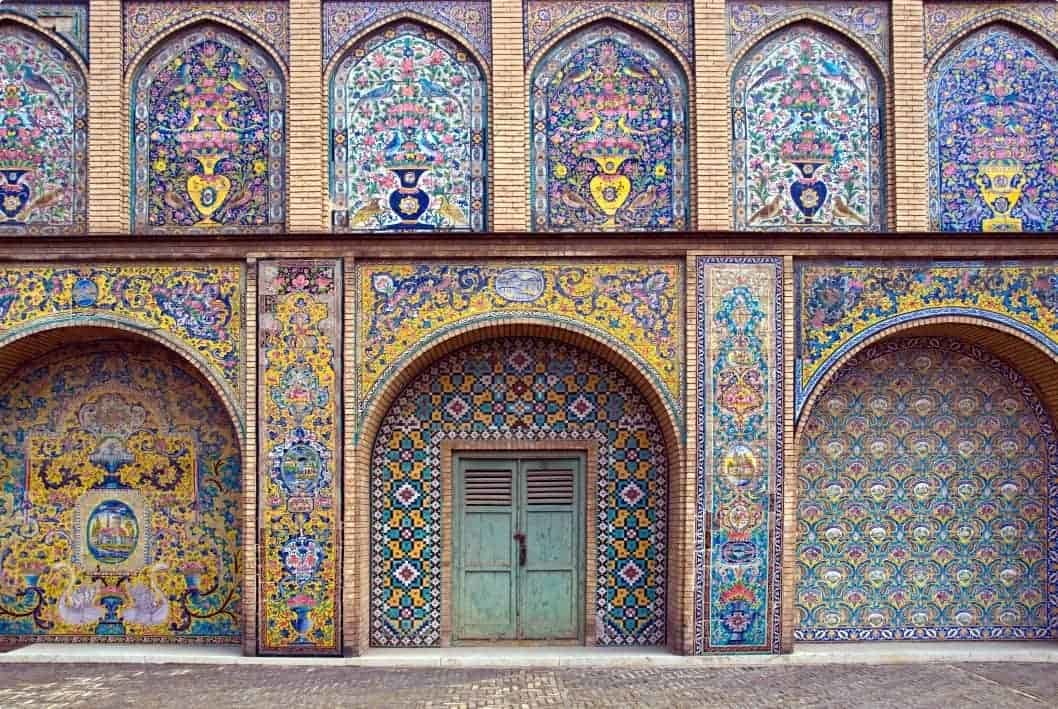
Yazd:
Yazd is an historic Silk Road oasis town set to the east of the Zagros mountains between two deserts. The extremely hot temperatures in summer led to the development of architecture adapted to its desert surroundings. Consequently, it’s nicknamed Shahr-e Badgirha (the City of Windcatchers), after its many fine badgirs (wind towers). These rely on the wind and convection to cool houses and the water reservoirs in the town area.
After the Arab conquest of Iran in the 7th century, many Zoroastrians migrated to Yazd from neighbouring provinces. The Arabs allowed Yazd to remain Zoroastrian even after its conquest, and Islam only gradually became the dominant religion in the city. Yazd’s Old City area is one of the oldest towns on earth. The old city is a warren of sun-dried mud brick homes dominated by tall badgirs and high walls — a wonderfully historic place perfect for a good wander around. The Jameh Mosque, built in the 15th century, has one of the tallest entrance portals in Iran, including two 48m high minarets. The mosque is built on the site of a 12th century building that was once an earlier fire temple.

Sights around Yazd
- Meybod is and ancient village some 50 kilometres north of Yazd. Built of mainly mud brick houses, this village is at least 1,800 years old. It has several buildings and structures typical of old Iran including a caravanserai, an underground qanat water supply system, a ‘fertiliser’ factory (!) in the form of a pigeon tower, a huge Safavid era ice house, and in the centre of town, the Narein Castle, thought to be one of Iran’s oldest.
- The haunting Towers of Silence, now on the outskirts of the city. Yazd was one of the strongholds of Zoroastrianism. In accordance with Zoroastrian beliefs about the purity of the earth, dead bodies were not buried but placed in uncovered stone towers — the Towers of Silence — where birds could pick the bodies clean. They were last used in the 1960s.
- On a slightly more cheerful note, confectionery! Today, Yazd is famous for for its sweets which have a tremendous following throughout Iran. Recipes are closely guarded secrets! Baklava, ghotab and pashmak are the most popular sweets made in the city.
Northwestern Iran
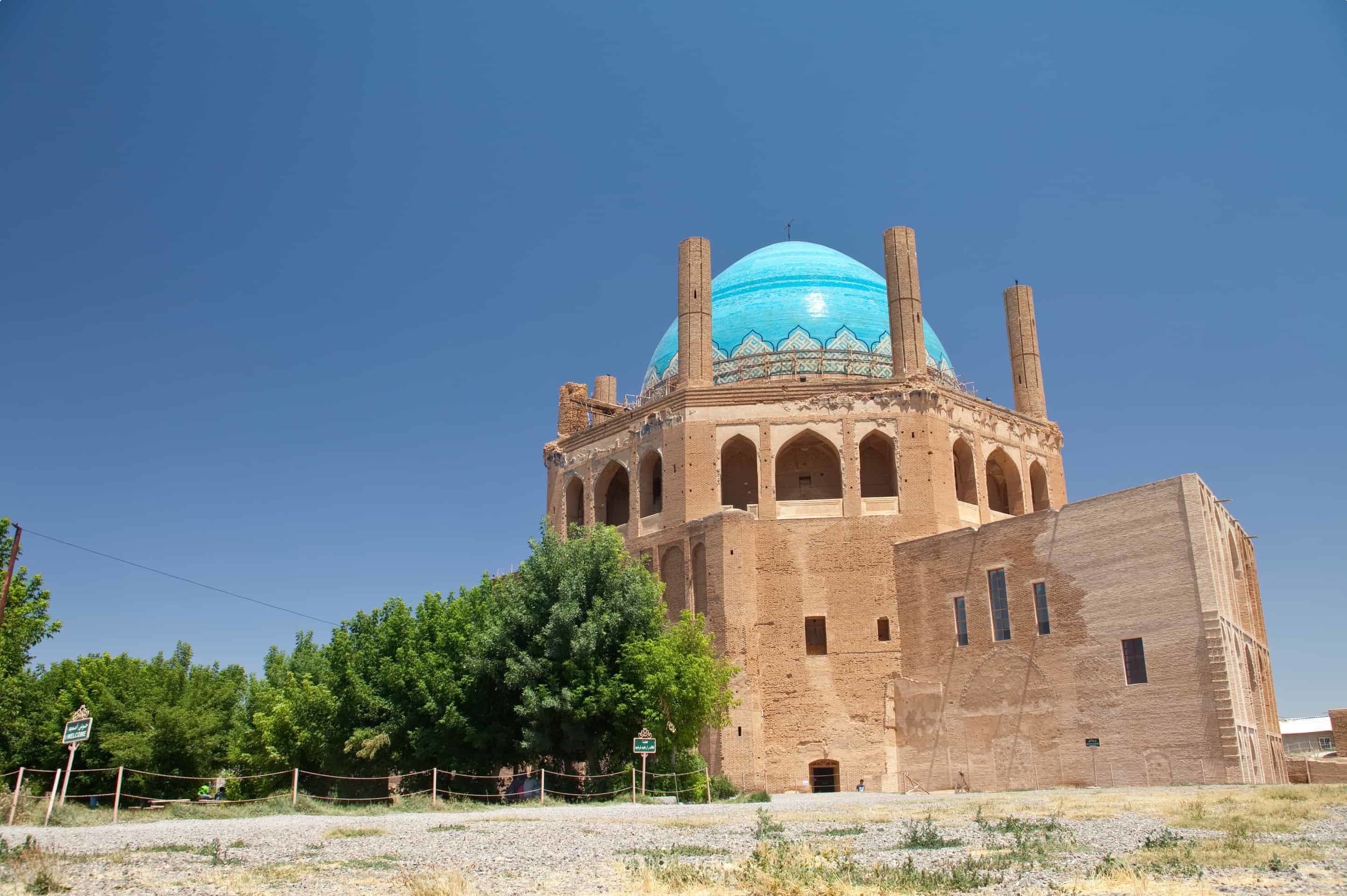
The northwestern area of Iran is home to two of Iran’s UNESCO World Heritage listed sites, Takht-e Soleyman (the Throne of Solomon), and the mausoleum of Oljaytu at Soltaniyeh.
- The Mongols built Soltaniyeh as their capital in 1302, but Tamerlane destroyed it less than a century later. Fortunately, the mausoleum of the Mongol Sultan Oljaytu Khodabandeh, usually known as the Soltaniyeh Dome, survived. It’s one of the outstanding examples of Persian architecture and a key monument in the development of its Islamic architecture. The octagonal building has a 50m tall dome, covered in turquoise blue faience, and surrounded by eight slender minarets. The stunning interior features decorative stone and ceramic tiles.
- (the Throne of Solomon) includes Iran’s main Zoroastrian sanctuary, the Azergoshnasb Fire Temple. By the 3rd century CE, the state religion of Sassanian Persia was Zoroastrianism and this was its centre. By this stage, Zoroastrianism had incorporated many Magi-inspired elements including the veneration of earth, wind, water and fire, all elements found here. The whole site and its ruins are set around an extinct volcanic crater filled by running underground water, set high in the surrounding mountains. The designs of the fire temple, the palace and the general layout strongly influenced the development of Islamic architecture. The site also has a temple from the Sassanian period dedicated to Anahita, an ancient goddess of water, who became associated with fertility, healing and wisdom.
Hamadan

Hamadan, once known as Ecbatana, was one of the ancient world’s greatest cities. It lies on the legendary Silk Road between Mesopotamia and the Iranian Plateau. According to Greek historians, the Median king Deiokes fortified a palace here in 728 BCE. This grew into a city fortified with massive walls with seven layers — the inner two coated in gold and silver and the outer one as long as that of classical Athens. The city’s fortunes rose and fell in line with the fortunes of war and went into a major decline following an 18th century Turkish invasion. A recently-built monument recognises the achievements of the great Iranian philosopher, physicist and poet Abu Ali Ibn Sina, known as Avicenna in Europe, who died here in 1037. His scholarly work on medicine, Canon Medicinae, is so significant he is considered the father of modern medicine and pharmacology.
Places of interest near Hamadan
- The Alisadr Caves have a river, up to 14m deep, flowing through the middle. You can explore the caves by boat along channels leading to an enormous underground atrium.
- The Temple of Anahita at Kangavar. Classical historians have written that the temple was a vast palace built in wood and covered by plates of silver or gold. The floor tiles were silver, and the whole building faced with bricks of silver and gold. Alexander the Great’s forces plundered this incredible wealth around 331 BCE.
- Taq-e Bostan (the Arch of the Garden) is a towering cliff inscribed with extraordinary Sassanian bas-reliefs, set in and around a pair of carved alcoves. The site is in a beautiful setting on the Silk Road and the reliefs are adjacent to a spring that empties into a large reflecting pool at the base of the mountain cliff.
- The World Heritage listed archaeological site of Bisotun sits alongside the ancient trade route linking the Iranian high plateau with Mesopotamia. It features remains from prehistoric times through to the Median, Achaemenid, Sassanian, and Ilkhanid periods. Its main sight is the bas-relief and cuneiform inscription of Darius the Great, from when he rose to the throne of the Persian Empire in 521 BCE. It portrays Darius holding a bow as a sign of sovereignty, treading on the chest of a figure who lies on his back before him. According to legend, the figure represents Gaumata, the Median pretender to the throne whose assassination led to Darius’s rise to power. Below and around the bas-reliefs there is an inscription of around 1,200 lines which tells the story of the battles Darius waged against the governors who attempted to take apart the Empire.
Kashan
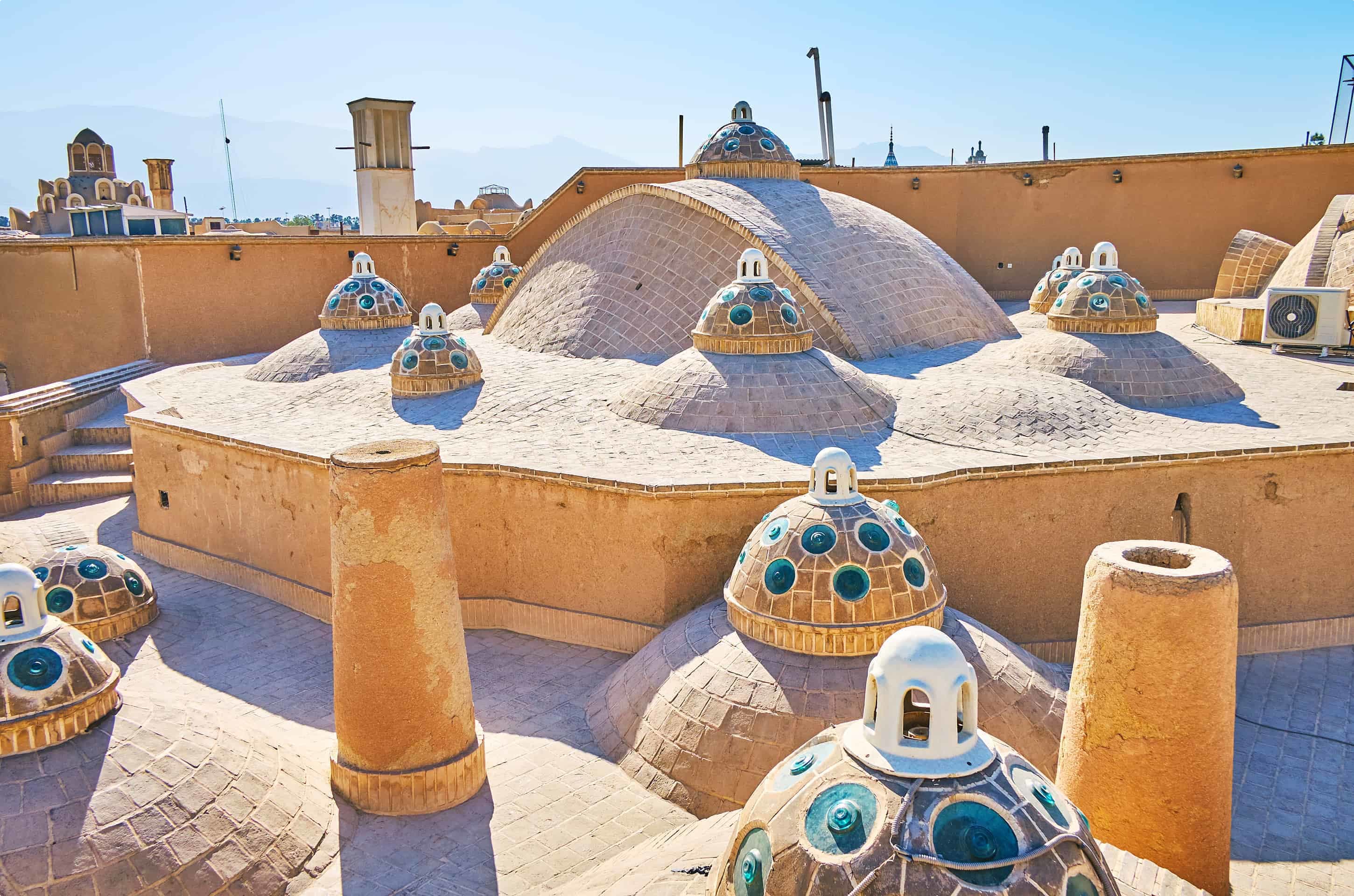
First settled in the 4th millennium BCE, the history of the lovely city of Kashan is interwoven with legend. One oral history has the Bible’s Three Wise Men setting out from here to pay their respects to the baby Jesus. This is distinctly possible, as the Three Wise Men were magis (Zoroastrian priests) — hence ‘the Adoration of the Magi’. During the Seljuk period (1051-1220 CE), Kashan became famous for its textiles, pottery and tiles. Shah Abbas I is buried in Kashan instead of in Esfahan because he liked it so much. Must-see sights in Kashan include:
- The Fin Garden is over 1,000 years old, and was a summer retreat by some of the Safavid kings. It’s a classical Persian vision of paradise, famous for its spring water. This is channelled through several pools and fountains to water the garden’s orchards and trees.
- A wealthy carpet merchant named Seyyed Ja’far Tabatabei built the Khan-e Tabatabei around 1880. The house is famous for its intricate stone reliefs and its fine stucco, mirror and stained glass decoration. It has three sections: the andaruni, where family members lived; the biruni used for entertaining guests; and the khadameh (servants’ quarters).
- In the 1890s, a merchant known as Borujerdi, who wanted the hand of Seyyed Ja’far Tabatabei’s daughter in marriage, built the Khan-e Borujerdi. Its reception hall features frescoes painted by Kamal ol-Molk, the foremost Iranian artist of the time.
The best time to tour Iran
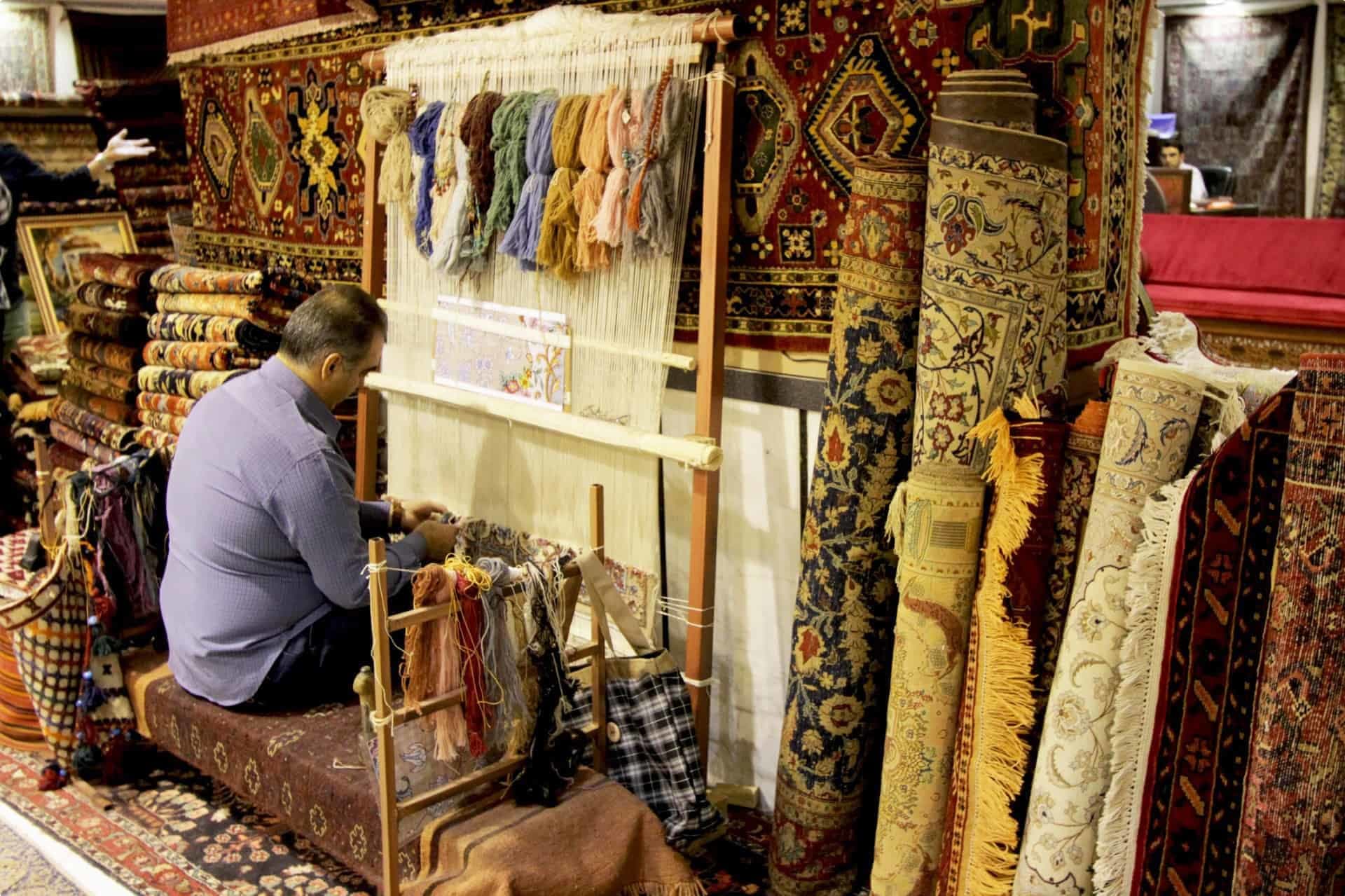
The best times to take one of Odyssey’ Travellers Iranian tours are in spring (September to November), and autumn (March to May). Temperatures can vary widely according to altitude and whether you’re near one of the two main deserts, however, these are the best times to be in Iran overall. The days will be clear and sunny and generally mild. For more information on the best time to go travelling in Iran, click here.
What to wear when travelling in Iran
Since the revolution in 1979 all women, including foreigners, must, by law, wear loose-fitting clothes to disguise their figures. They must also cover their hair, neck and décolletage. This way of dressing is known as hejab. It’s a term referring specifically to one’s hair-covering, but it also refers in general to modest dress. The most important item of clothing is a manteau — a long, loosely fitted coat or coat-dress — and a head scarf.
In reality, the dress code is open to wider interpretation in the larger cities. It’s not unusual to see young women wearing figure-hugging manteaus, skinny jeans, high heels and colourful scarves arranged to offer plentiful glimpses of hair and neck. However, the smaller cities and towns in Iran are more conservative. Foreign women are not usually judged as harshly as Iranian women when it comes to hejab. However, women travelling in Iran need a manteau, a couple of head coverings, and something to fasten these with. Your clothes don’t need to be black or dull, bright colours are completely acceptable.
Clothes for women: manteaus and head scarves
A manteau is an item of clothing that is loose fitting and covers your bottom. Loose cardigans reaching down to the mid-thigh are modest and comfortable, and you can wear them over t-shirts or jumpers. Long peasant style blouses or loose shirts reaching to your mid-thigh also work well. You can wear your manteau over pants (jeans are fine), but if you prefer wearing long skirts, you must wear socks too. The trench coat is the most popular version for fashion-conscious Iranian women, but it can be hot and uncomfortable in the warmer areas. However, you can always just put it on over your underwear! Your manteau and head scarf will need to stay on in all public places — that means restaurants, shops and everywhere you go sightseeing. Generally these items will go on before you walk out of your hotel room door and won’t come off until you return.
Head scarves
The biggest challenge you’ll encounter is keeping your head scarf on. Heavy silk tends to slip off, and the only way to make this work is to tie them under the chin. Some travellers wear an elasticised headband and fasten their scarves to it with safety or bobby pins. This works well with silk and fine cotton, so is worth considering. Textured cotton or wool tends to adhere to hair more effectively and slips less. Just make sure that your scarf is wide enough to cover all of your hair, and long enough to be able to throw over your shoulders as an anchoring device. Practice before you leave home to see what works best for you. Remember, you’ll need to be wearing hejab when you arrive at Tehran Airport!
Clothes for men
Men should pack long trousers or jeans, and short and long-sleeved shirts (long sleeves provide excellent sun protection too). For the cooler areas you can wear warmer trousers, and add a jumper or jacket.
A brief history of Iran
 The Elamites established the first settlements in Iran around the middle of the 3rd millennium BCE. By the 12th century BCE, they were in control of most of today’s western Iran, the Tigris Valley and the coast of the Persian Gulf. Around this time Indo-European Aryan (Persian) tribes began arriving from the north, eventually settling in today’s Fars province, around Shiraz. Meanwhile, the Medean people settled north-western Iran with their capital at Ecbatana (today’s Hamadan). Under their king Cyaxares, they became a formidable military force, sacking the Assyrian capital of Nineveh (in today’s Iraq) alongside the Babylonians. The first great Persian Empire began in the 7th century BCE with the Achaemenid dynasty. Their ceremonial capital, Persepolis, became the hub of an empire spanning today’s Uzbekistan and Afghanistan in the east, to the Macedonian border. Modern-day Egypt, Jordan, Israel, Syria, Turkey, Iraq and Iran all lay within its borders.
The Elamites established the first settlements in Iran around the middle of the 3rd millennium BCE. By the 12th century BCE, they were in control of most of today’s western Iran, the Tigris Valley and the coast of the Persian Gulf. Around this time Indo-European Aryan (Persian) tribes began arriving from the north, eventually settling in today’s Fars province, around Shiraz. Meanwhile, the Medean people settled north-western Iran with their capital at Ecbatana (today’s Hamadan). Under their king Cyaxares, they became a formidable military force, sacking the Assyrian capital of Nineveh (in today’s Iraq) alongside the Babylonians. The first great Persian Empire began in the 7th century BCE with the Achaemenid dynasty. Their ceremonial capital, Persepolis, became the hub of an empire spanning today’s Uzbekistan and Afghanistan in the east, to the Macedonian border. Modern-day Egypt, Jordan, Israel, Syria, Turkey, Iraq and Iran all lay within its borders.
The Safavid Empire
The third great Persian Empire arose during the Safavid dynasty, following a tumultuous period when the region was occupied by the Mongols. Widespread devastation of property and people began under Genghis Khan in 1218, again under his grandson Hulagu, and then by their successors led by Timur (aka Tamerlane), in the mid-1350s. During this period several descendants of Hulegu, including his great-grandson, Oljaytu, ruled and most converted to Islam. Shah Abbas I rebuilt Esfahan and it became the envy of rivals and of interest to travellers as one of the most magnificent cities in Persia. Shiraz also blossomed during the 13th and 14th centuries to become a leading centre for calligraphy, painting, literature and architecture. This development of Persian arts, philosophy, medicine, astronomy, and mathematics became major elements of the Islamic civilisation setting Persia apart from her neighbours.
 Later history
Later history
Prior to the revolution of 1979, three rather ineffectual sets of rulers, Nader Shah, the Qajar dynasty and the Pahlavis, controlled Iran. After Nader Shah’s death the empire shrank greatly in size. During the Qajar period Russia and Great Britain tried dominating the region, Russia in the north and the British in the south. Both eventually took control of the country’s main natural resource, oil. The Pahlavi Shahs repealed the privileges granted to foreign powers, and nationalised Iran’s oil resources. Unpopular decisions led to voices of dissent in religious circles, including by the Ayatollah Khomeini. Pahlavi extravagance and broken promises for social reform saw an uprising calling for the dismissal of the rulers and the return of the exiled Ayatollah. This eventually came to pass in 1979, along with the formation of the Islamic Republic of Iran.
Iran today
In 2013, Hassan Rouhani won the presidential election, reiterating his promise to recalibrate Iran’s relations with the world. In 2015, Iran and the UN Security Council signed off on the framework of a deal to redesign, convert and reduce Iran’s nuclear facilities.
Shia and Sunni Muslims
Practitioners of the Islamic faith, known as Muslims, follow five precepts known as the ‘pillars of Islam’. The first, the shahada, holds that there is no god but Allah, and Mohammed is his prophet. The other four pillars are prayer, alms-giving, fasting during Ramadan, and the haj, the pilgrimage to Mecca. Muslims believe that Jesus was also a prophet, second only to Mohammed. When the Prophet Mohammed died in 632 CE, disagreement broke out over his successor. The majority backed Abu Bakr, the prophet’s father-in-law and friend, and he became the Caliph instead of the Prophet’s son-in-law and cousin, Ali bin Abi Taleb. He eventually got the position in 656, but was assassinated five years later. By then the Muslim community had fractured into two factions: the Sunnis, who followed Abu Bakr, and the Shi’ite (or Shia, meaning ‘followers of Ali’).
The word ‘Sunni’ is from the word sonnat, meaning tradition. It refers to the fact that Sunnis follow the traditional line of succession after the Prophet Mohammed. The majority of the world’s Muslims (85%-90%) are Sunni, spread across Africa, the Middle East and Asia. The Islamic Republic of Iran is the only Shia Muslim country in the world.
Zoroastrianism
The religion of pre-Islamic Iran, Zoroastrians follow Zoroaster (also known as Zarathustra), a mystic probably born between 1000 and 1500 BCE. Zoroaster was one of the first to postulate an omnipotent, invisible god. The supreme being, Ahura Mazda, has no symbol or icon, but he asked followers to pray to him in the direction of light. As the only light the ancients had was fire, Zoroastrian fire temples keep his flame burning eternally. Zoroastrianism is also known as Ahura Mazdaism, and as Magism after its ancient priests, the Magi. It was the main religion until the Arab conquest brought Islam to the fore.
The core lesson of Zoroastrianism is one of duality — the everlasting battle between good and evil. These two opposing ‘minds’ coexist within Ahura Mazda, and in all living things. As Zoroastrians believe in the purity of the elements (earth, wind, fire and water), they did not bury their dead, or cremate them. Consequently, they built ‘Towers of Silence’, laying out the dead on the summit for carrion birds to consume. Today, Zoroastrians have graves with a concrete lining.
Iranian cuisine
Iran remains one of the few places left in the world not (yet) saturated with fast food chains. Many towns and cities are famous for particular dishes, especially sweet treats! Don’t miss trying saffron ice cream while strolling around Esfahan, frozen noodles in Shiraz, and Yazd’s famous sweets.
Iranians eat rice, along with meat, chicken or fish, for their main meal. Kebabs sprinkled with sumac are also common. Sumac often comes in its own shaker on the table alongside the salt and pepper! Herbs are another frequent accompaniment, along with vegetables and raw onion. Garlic, saffron, dried limes, cinnamon, and parsley are all common flavours. Iranians also usually eat plain yoghurt, or yoghurt mixed with mint or cucumber, with lunch and dinner. Hotel breakfasts typically include porridge, eggs, soft cheese, cut tomatoes, cucumber, yoghurt, fruit juice, flat breads (nan), butter, jam and tea (chai).
Visit Iran With Odyssey Traveller
Odyssey Traveller offers two fully escorted trips to Iran each year, one in spring and one in autumn. We begin our tour in bustling Tehran, where we take in colourful traditional art and handicrafts at a number of museums. We then head to several of Iran’s ancient cities, Zanjan, Takab, and Hamadan, each home to important UNESCO World Heritage Sights. Our trip also visits Esfahan, regarded in the Middle Ages as ‘half the world’, and still Iran’s most beautiful city. We also head to the stunning desert city of Yazd, and Shiraz, famous as the ‘city of poets’, from which we make a day trip to Persepolis, capital of Darius the Great.
Our trip to Iran is designed for mature and senior travellers, either couples or those making their journey as a solo traveller. Our groups are always led by an experienced tour operator and local guides, who share the culture and history of Iran with you. We understand that the local cuisine is a vital part of culture, and make sure to include meals at authentic local restaurants.
For your Iran holiday, think about joining an Odyssey tour. We promise a memorable experience of this fascinating country. To see the full itinerary for our forthcoming tours click here, and please call or send an email if you have further enquiries.
Here is the testimony of one Odyssey traveller:
I have never met such friendly people as the Iranians and the country has some of the most interesting and memorable sights to visit. The Persian empire and history is a fascinating subject. Most people did not really know what to expect but were more than pleased by the whole experience. The country presently appears to be very stable and very safe. TM, February, 2016
The Australian Government’s Smartraveller.gov.au site provides advice for Australians on travelling in Iran. For their latest advice, click here.
